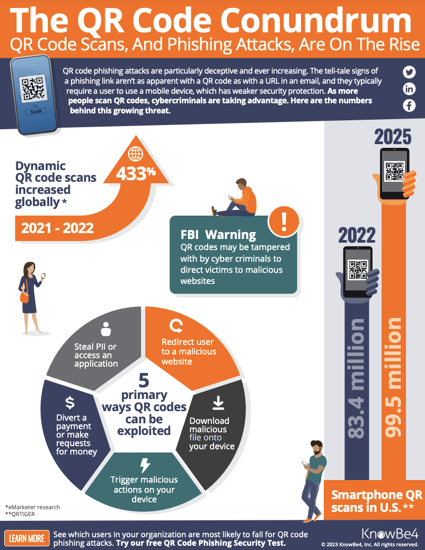 According to QRTIGER, an online QR code generator company, dynamic QR code scans increased 433% globally from 2021 to 2022. In 2022, the FBI released a warning that QR codes may be tampered with by cybercriminals to direct victims to malicious sites.
According to QRTIGER, an online QR code generator company, dynamic QR code scans increased 433% globally from 2021 to 2022. In 2022, the FBI released a warning that QR codes may be tampered with by cybercriminals to direct victims to malicious sites.
With the increased popularity of QR code usage throughout the world, users are more at risk of a phishing attack than ever. A malicious link hidden in a QR code can bypass traditional email filters.

- Dynamic QR code scans increased by 433% globally from 2021 to 2022
- Smartphone QR scans in the U.S. are projected to increase from 83.4 million to 99.5 million from 2022 to 2025
- The FBI has issued a warning that QR codes may be tampered with by cyber criminals to direct victims to malicious websites
- QR codes can also be exploited to steal PII, divert payments, download malicious files, and more
Additionally, the tell-tale signs of a phishing link are not as apparent with a QR code because it is difficult to validate and lures your users to switch to their mobile device with weaker security protection. This leaves your organization vulnerable to QR-based phishing attacks, putting your brand and network in jeopardy.
Do you think your users would scan an untrusted QR code, potentially disclosing sensitive information?
To see which users in your organization are most likely to fall for QR code phishing attacks, try our free QR Code Phishing Security Test. (QR Code PST). This new tool helps you identify users that are most susceptible to these types of attacks so you can train them to think twice before scanning QR codes and build a stronger security culture.
 Here's how it works:
Here's how it works:




